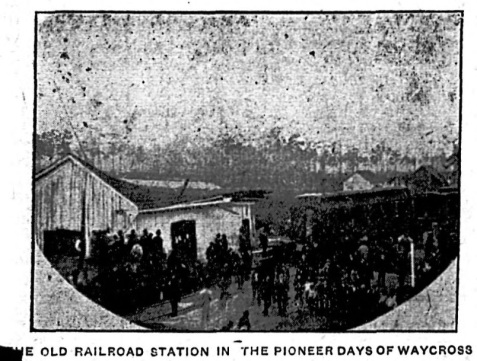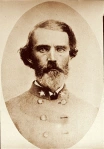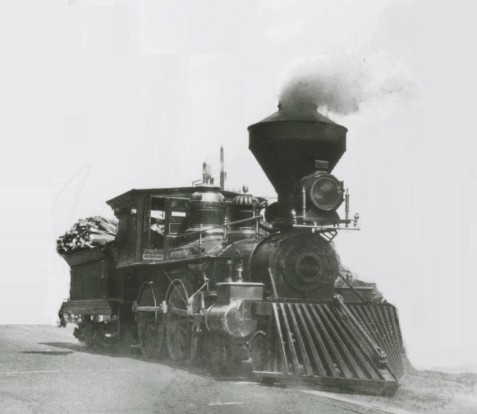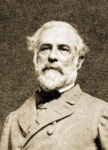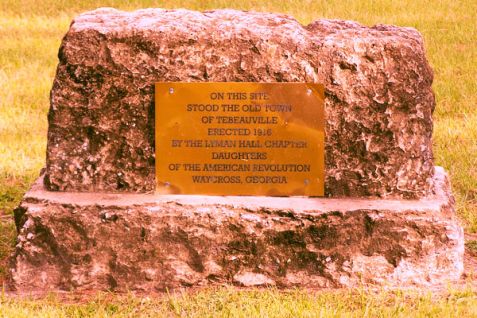When the very first train rolled into the newly laid out town of Valdosta, GA, the state newspapers reported the “neigh of the Iron Horse” was heard. Valdosta was Station No. 15 on the Atlantic & Gulf Railroad and the first train, arriving on July 25, 1860, was pulled by the locomotive “Satilla.” Levi J. Knight, original settler at Ray City, GA, was instrumental in bringing the railroad to Lowndes County. Over time, the trains would bring new economic & tourism opportunities to Wiregrass Georgia, such as Henry Bank’s Elixir of Life mineral springs at Milltown (now Lakeland), GA
The track of the A & G “Main Trunk” Railroad had one month earlier reached Station No. 14, Naylor, GA, sixteen miles east of Valdosta.
The Valdosta (Lowndes Co.) Watchman, on last Tuesday [June 26, 1860], says:
“The ware-house at Naylor Station (No. 14) has been completed, and freight is now regularly received and forwarded. The grading on Section 29 is finished to the eastern boundary of Valdosta, the cross ties are being distributed along the line, and nothing save some unforeseen providential contingency can postpone the arrival of the train at No. 15 longer than 20th July ensuing. The whistle of the Steam Horse has been heard repeatedly in our village the past week.”
The railroad had been built largely by the labor of enslaved African-Americans. The construction had commenced in 1859 at Tebeauville, GA.
For the opening of the tracks to Valdosta, the town invited the A & G railroad executives and prominent citizens of Savannah to a grand celebration of the event. Three thousand people were at Valdosta for the Jubilee held July 31, 1860.
Macon Weekly Georgia Telegraph
August 10, 1860Railroad Jubilee at Valdosta
The Valdosta Watchman says, the opening of the Atlantic & Gulf Railroad to that place was celebrated with a public dinner. A train of seven passenger cars brought numerous guests from Savannah and intermediate places on the road, who arrived at Valdosta at one o’clock, and were welcomed with the heavy booming of a nine pounder.
On the same day the friends of Breckinridge and Lane held a meeting, ratified the nominations, appointed five delegates to Milledgeville and were addressed by Col. Henry R. Jackson and Julian Hartridge, Esq.
Among the prominent attendees:
- Reuben Thomas “Thompy” Roberds, Mayor of Valdosta; attorney; owner of 10 enslaved people
- John Screven, President of both the “Main Trunk” Atlantic & Gulf Railroad and the Savannah, Albany & Gulf Railroad; Mayor of Savannah; State Representative from Chatham County; a rice planter on the Savannah River; owner of Proctor Plantation, Beaufort, SC; owner of 91 enslaved people.
- Gaspar J. Fulton, Superintendent of the “Main Trunk” Atlantic & Gulf Railroad and of the Savannah, Albany & Gulf Railroad; owner of 11 enslaved people.
- Julian Hartridge, State Representative; owner of four enslaved people
- Robert Grant, Savannah attorney
- Henry Rootes Jackson, prominent attorney and prosecutor of Savannah; former U.S. Minister Resident to the Austrian Empire; owner of 11 enslaved people. In the Civil War while serving as a major general in the Confederate States Army, Henry R. Jackson’s command included the 29th Georgia Regiment and the Berrien Minute Men.
- Col. E. R. Young, of Brooks County, GA
- Col. Thomas Marsh Forman, former state senator, wealthy planter of Savannah, owner of Broughton Island, political rival of Julian Hartridge, son-in-law of Governor Troupe, owner of 171 enslaved people in Chatham, Laurens and Glynn County, GA.
- Young J. Anderson, of Savannah, former Solicitor General of the Eastern Circuit, attorney and owner of 6 enslaved people. One enslaved woman was the remarkable Rachel Brownfield, who through her own efforts earned enough to buy her own freedom, but Anderson reneged on the deal.
- Joseph John “JJ” Goldwire, accountant, resident of Valdosta
- Dr. Augustus Richard Taylor, resident of Valdosta
- Benjamin F. Moseley, alumnus of the University of Georgia, resident of Georgia Militia District 662 (Clyattville District); his brother, Augustus Moseley, owned 33 enslaved
- William Zeigler, wealthy planter of Valdosta and owner of 46 enslaved people.
- Sumner W. Baker, Troupville, GA attorney residing at Tranquil Hall hotel
- Rufus Wiley Phillips, Troupville, GA attorney; owner of three enslaved people; later mayor of Valdosta and a judge of Suwannee County, FL
- Lenorean DeLyon, editor of the Valdosta Watchman newspaper; his brother, Isaac DeLyon, was the first station agent for the Atlantic & Gulf Railroad at Valdosta. A niece, Lenora DeLyon, was a passenger on the first train to reach the town.
Savannah Daily Morning News
Thursday Morning, August 2, 1860Railroad Celebration at Valdosta.
In response to the invitation of the citizens of Lowndes county to the officers and Directors of the Savannah, Albany & Gulf Railroad and the citizens of Savannah, to join with the people of Lowndes and the adjoining counties in celebrating the completion of the Main Trunk to that point, in company with a number of gentlemen we left the city in a special train for Valdosta, at 5 o’clock on Tuesday morning [July 31, 1860]. Not withstanding the extreme heat of the weather, and the dustiness of the track, the trip, over a good road, through a county so recently almost a wilderness, but which is already beginning to exhibit evidences—in its increasing population, rising towns, and growing prosperity and enterprise, of the great benefits which must result to our section of the State from the completion of this great work—was both interesting and pleasant. As the train progressed, and as we neared the point of destination, our party was increased by continual accessions of people, and by the time we reached Valdosta, the cars were filled to the extent of their capacity.Arriving at Valdosta about two o’clock, we were surprised to find a gathering of some three thousand people, of whom a large proportion were ladies and children—the town surrounded by vehicles of every description, and saddle horses tied to the trees in every direction. The company had just partaken of a most bountiful and well-prepared barbecue, which was spread out upon tables under a shed erected for the purpose. The guests from Savannah were cordially received by the committee, by whom we were invited to the tables, and introduced to many of those present.
After the company had retired from the tables, a meeting was organized by calling Col. E. R. Young, of Brooks county, to the Chair, and appointing Dr. Folsom, Secretary. The object of the meeting having been stated by the chairman, Capt. John Screven, President of the Savannah, Albany & Gulf and Main Trunk Railroads, responded to the general call in an eloquent and appropriate address, in which he spoke of the interesting event to celebrate which, in a becoming manner, he was happy to see so many of fellow citizens and fair countrywomen of Southwestern Georgia assembled in Valdosta. He alluded to the immense benefits which must result to the people of the interior and the cities of the seaboard from the completion of the great iron link which was to bind them together in bonds of mutual Interest and mutual friendship. Capt. Screven’s address was received with demonstrations of cordial approval.
Brief and appropriate addresses were also delivered in response to the call of the meeting by Hon. Henry R. Jackson, Julian Hartridge, Esq., Col. Thos. M. Forman and Y. J. Anderson, Esq., of Savannah, S. W. Baker,Esq., Chairman of the Committee of arrangements, also addressed the meeting. Other gentlemen were also called by the meeting, among them Robert Grant, Esq., of this city. None of them responding, the meeting was finally adjourned, and the immense crowd, most or whom had many miles to travel to their homes, began to disperse. Some objection having been made to a proposition to reorganize the meeting as a political meeting, notice was given that the friends of Breckinridge and Lane would reassemble at the Court House for the purpose of holding a ratification meeting.
A large portion of those present repaired to the Court-house, where a meeting was organized by calling William B. Zeigler, Esq., to preside., and appointing R. T. Roberds
esq., secretary.
The official proceedings of this meeting, which was a very spirited and enthusiastic demonstration of the prevailing sentiment, not only of Lowndes but of the surrounding counties and throughout that section of the State, in favor of Breckinridge and Lane and sound State Rights principles, will be found in another column or our paper.
Judge Jackson, being Invited to address the meeting, made one of his happiest and most effective efforts. After a brief history of the action of the Charleston and Baltimore Conventions, and a fair statement or the great Issue before the country, he confined himself mainly to a most searching review of the political record of John Bell, whom he clearly demonstrated had given evidence by his frevuent votes against the South, and with the North, that his ambition is stronger than his patriotism, and that he is utterly unworthy the confidence of the South in a crisis like the present.
Mr. Hartridge, followed Judge Jackson in one of the ablest and most forcible political speeches we have ever heard him deliver.
Col. Forman, In response to the call of the meeting made a brief and pertinent speech which was also well received by the meeting.
Alter the passage of the resolutions and a vote of thanks to the speakers, the meeting adjourned with three hearty cheers for Breckenridge and Lane.
The crowd at Valdosta on Tuesday comprised a full and fair representation of the people of that portion of Georgia, its brave men, its fair women, and bright youth; and was one of the largest as well as most respectable assemblages we have ever seen brought together in the interior and more sparsely populated sections of our State. As we contemplated the vast crowd, and looked upon Valdosta, just emerging from the native pine forest, then echoing the first startling neigh of the Iron horse, who, as he leaps the heretofore impassable barriers that have shut out Southwestern Georgia from the commerce of the world, we endeavored to picture to our mind the great change which a few years must bring to this long neglected and almost unconsidered portion of our noble Slate.
Valdosta, the present terminus of the Main Trunk road, is distant from Savannah 155 miles. The first trees upon its site were felled In February last, and though only a little more than six months old, its present population numbers about five hundred souls. It is handsomely laid out, and though the native trees still obstruct its streets, it has three or four dry goods stores, two grocery stores, two hotels, two steam mills, a court-house, several neat private residences, and last, not least, a printing office and a newspaper.
The Valdosta Hotel, at which we stopped, is well kept by very kind and obliging people, who made up by their willing efforts for whatever they lacked of ability to provide accommodation for a crowd that would have given even our Pulaski House something extra to do. In the emergency of the case we are greatly Indebted to Mr. J. G. Fulton, the worthy Superintendent of the Road, who kindly provided us and many others with excellent sleeping quarters for the night on the cars.
The perfect safety with which the entire trip was made over the road, on a considerable portion of which the rails have been but recently laid, bears testimony alike to the excellence of the road itself and to the carefulness and attention of its employees.
————————♦————————
Breckinridge and Lane Meeting at Valdosta.
There was a barbecue given at the above place on Tuesday, 31st July, to celebrate the arrival or the cars at Valdosta, the friends of Breckinridge and Lane availed themselves of this opportunity to hold a ratification meeting, and assembled, after the close of the exercises pertaining to the railroad celebration, in the Court house at Valdosta, In the afternoon of the same day for that purpose.
On motion of Mr. J. J. Goldwire, Mr. William Zeigler was called to the Chair, and R. T. Roberds requested to set as Secretary.
Mr. Goldwire then introduced the resolutions, which were unanimously adopted:
1st, Resolved, That we, the Democracy of Lowndes county, do hereby ratify the nominations of John C. Breckinridge and Joseph Lane, for the Presidency and Vice Presidency of the United Slates, and we pledge to them our hearty and undivided support, believing, as we do, that it is high time for the people of the South to be united and vigilant In the recognition and enforcement of their constitutional rights.
2d. Resolved, That the Chairman of this meeting do now appoint five delegates to represent the county of Lowndes in the Democratic Convention to assemble at Mllledgevllle on the 8th of August next, to nominate an electoral ticket to cast the vote of Georgia in the Presidential election.
3d. Resolved, That should it be inconvenient for any one of said delegates to attend said convention, that those who do go be instructed to cast their votes for them, having the same power of the original delegates.
The following gentlemen were appointed by the Chair, to wit: Benjamin F. Mosely, R. W. Phillips, J. J. Goldwire, Dr. A. R Taylor, and Col. Leonorean DeLyon.
Col. H R. Jackson being present, was called on to address the meeting, which he did in his usually eloquent and forcible manner, entertaining his audience with satisfaction for a consider able time, notwithstanding they were fatigued with the other exercises of the day, and so situated as to have to stand to listen at his speech.
At the suggestion of Col. Williamson, the privilege was extended to any one who wished to take part in the discussion In behalf of Bell or Douglas. No one responding.
Mr. Julian Hartridge was loudly called for, and addressed the meeting in an able and eloquent manner, clearly defining hit position, and giving a satisfactory account of his conduct as a delegate from Georgia in the recent Democratic Presidential Conventions.
Col. Thomas M. Forman was also called for, and addressed the audience in a few pertinent and entertaining remarks. Col. DeLyon moved that the thanks of the meeting be tendered to the speakers, which was. It was then moved that the proceedings of this meeting be published in the Valdosta Watchman, Savannah Morning News and the Georgia Forester.
The meeting then adjourned, with three cheers for Breckinridge and Lane, Jackson, Hartridge and Forman.
Wm. Zeigler, Chairman.
R. T. Roberds, Secretary.
————————♦————————
By 1862, the regularly scheduled trains of the merged Atlantic & Gulf Railroad and the Savannah, Albany & Gulf railroad passed through Valdosta, GA daily.
Related Posts:
- Tebeauville, Old No. Nine
- Lowndes Immigration Society, 1867
- General Levi J. Knight ~ Railroad Tycoon
- General Knight’s Railroad Rolls Into Civil War
- Railroad Horror! 1888 Train wreck kills John T. Ray and 30-odd others.
- Berrien Minute Men at Brunswick ~ July, 1861
- The Elixir of Life







